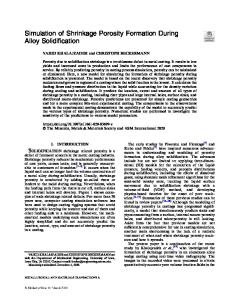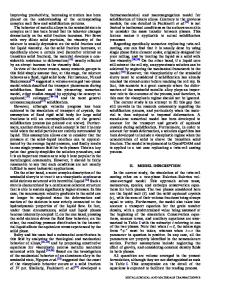Mechanisms of porosity formation during solidification: A theoretical analysis
- PDF / 1,452,101 Bytes
- 16 Pages / 603.28 x 783.28 pts Page_size
- 51 Downloads / 382 Views
I.
INTRODUCTION
C A S T I N G S are an important industrial raw material, and the properties of a casting determine, to a large extent, the quality of the final commercial product. In particular, porosity or shrinkage voids are usually undesirable. From our commercial experience, it appears that one half to three quarters of scrap castings are lost because of porosity and shrinkage. From a scientific point of view, the problem of porosity formation is complex and most interesting. The thermal properties of the alloy being cast (latent heat of fusion and thermal conductivity), the composition of the alloy (freezing range and dissolved gas content), the mold properties, and the geometry of the casting are all important to the properties of the final cast product. However, we do not know the relative effect of these variables, except in the qualitative way which comes from years of producing castings. The problem has been studied in detail for nearly 50 years, but there appears to be no clear agreement as to which mechanisms control the formation of porosity and shrinkage. In the absence of a clear scientific understanding, foundrymen have used empirical rules to design their molds. Chvorinov's rule is used to calculate the correct size of the riser, and it is well known that the riser can only feed a certain characteristic distance, called the feeding length. These rules were first observed and codified in the pioneering studies of Pellini, 11,21and they are still valid and useful today. Since Pellini's observations are of some importance to the theoretical analysis proposed in this study, it is useful to consider them briefly in detail. The feeding length of a riser is best considered by examination of Figure 1, taken from Pellini's original article. 12tThe data presented are for a steel bar cast in green sand. The distance from the riser to the end of the casting is sufficiently long that there is a central section which is "semi-infinite." In this G E O F F R E Y K. S I G W O R T H , Principal Engineer, and C H E N G M I N G W A N G , Analysis Engineer, are with Concurrent Technologies Corporation, Johnstown, PA 15904. Manuscript submitted December 13, 1991. METALLURGICAL TRANSACTIONS B
region, the solidification proceeds as if the bar had no ends and were infinitely long. In other words, the temperature in this region is uniform along its length, so the entire section freezes at the same time. Consider the experimental freezing velocity curve at the lower right-hand section of the figure. Five minutes after pouring, a shell 1.5-inches (40-mm) thick from the end has formed at the centerline of the bar. At 10 minutes, there is a region 3-inches (80-mm) thick which is completely solid. At 16 minutes, this shell has reached the right-hand end of the semi-infinite region, whose entire section now freezes. The freezing "wave" then slows down as it approaches the hot riser. Pellini 11"21observed centerline shrinkage in these central "semi-infinite" sections of plate and bar castings and in regions adjoining the semi-
Data Loading...











